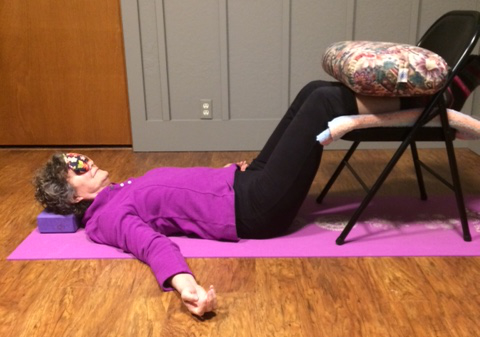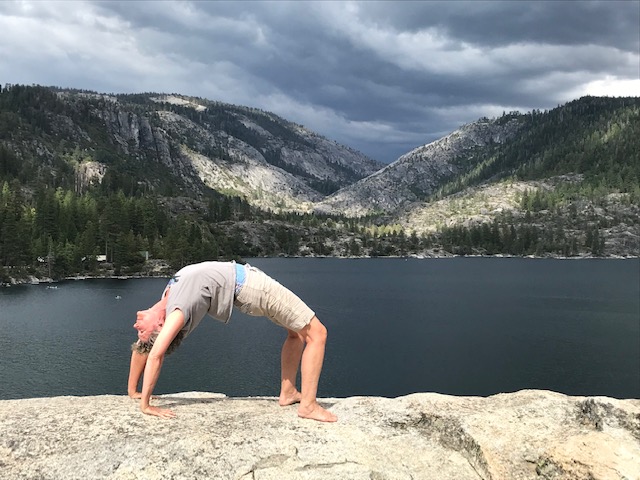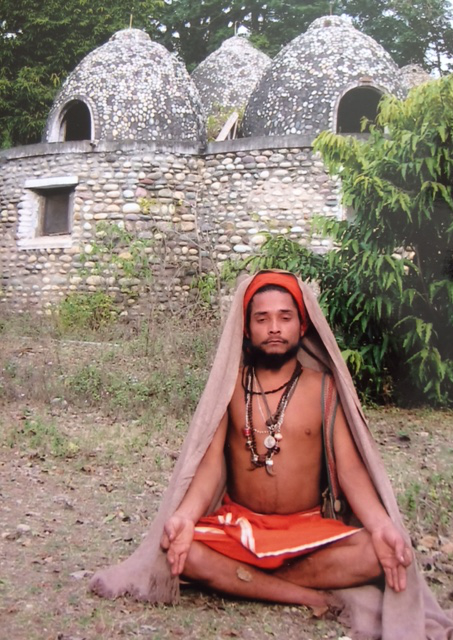The 21 Day Restorative Challenge
Dearest Friends,
As we all begin the tentative journey back to “normalcy” I’m reflecting on the highlights that brought joy into my Covid staycation life. My top four were: learning to play “Here Comes the Sun” on my ukulele, adopting two furry and neurotic four legged friends (our cats Lilah and Tony) connecting with friends and family via zoom and taking the 21 day restorative yoga challenge.
The 21 day challenge was one that several yoga communities promoted and practiced to help assuage the stress of the Covid shut in. The effects were so helpful and profound for me that when my high school girlfriends reconnected via Zoom to support each other through some major losses and health concerns they agreed to give it a try. Since the group (the 6-pack 😉 had varying degrees of yoga experience we practiced the simple but deep practice of Chair Savasana (see photo) with slow deep breathing for 20 minutes each day. I wanted to add some extra encouragement so I sent a text each day with a benefit that one can receive from doing the practice. My hope is that you will feel inspired to try this. The benefits are truly unlimited since the deeper we go, the broader is our capacity to experience them. There doesn’t have to be a crisis or pandemic in order to take this challenge. Can you really ever have too much joy or peace of mind?
The description of the posture and the 21 benefits and inspirations are shown below. I hope that it will encourage you to take the challenge.
It was such a thrill to see many of you from around the country, and a few from outside the country, in Zoom classes this past year. I have been contemplating what to offer in the fall and would love to hear some feedback from you. If there is interest, I would like to offer zoom classes one or two mornings a week, probably in 6 week sessions with some breaks in between. One morning would be a gentle level class and another morning would be a mixed level 1-2 with more active options. Being Zoom, the classes are more follow the leader than hands on so they are best for those who already have some in-classroom yoga experience.
I do not intend to travel beyond driving radius for weekend workshops going forward. I will be offering some intensive classes through other venues on Zoom as well as some teacher training and will have more details in coming newsletters. I will continue the winter Yoga In Paradise retreats for the foreseeable future most likely at Mar De Jade. The February 2022 retreat is currently full with a short wait list. Please let me know if you would like to be added. I continue to look for a local option for retreats and hope to be able to offer some in the beautiful Pacific Northwest.
I am deeply grateful for our encounters. Whether we have shared one class or many decades of them, they have left an imprint on my mind and heart.
With much love,
Lynne
THE 21 DAY RESTORATIVE CHALLENGE
Download the 21 Day Restorative Challenge as a PDF here.
 Chair Savasana
Chair Savasana
Lie on your back on the floor with your lower legs resting on a folding or other chair and raise your head a couple of inches on a pillow, folded blankets, or thin yoga block. Optional, but wonderful is to put some weight on the shins, heavy blankets or a bolster will do. Place a soft cover the eyes.
Practice deep full breathing. Work up to a count of 6-2-6-2, Inhale 6, pause 2, Exhale 6, pause 2. Stay with it for at least 5 minutes or as long as you can without strain. Then let go of the breath and relax deeply.
BENEFITS OF THE 21 DAY CHALLENGE
COUNTING DOWN FROM DAY 21
PHYSICAL BENEFITS
21. Elevating the legs slows the heart rate
20. Elevating the legs rests the heart.
Elevated legs and weight on calves assists venous return blood from the legs to the heart, easing the heart’s work of pumping the blood back to it from the lower extremities
19. Raises HRV (heart rate variability – variation in the time between consecutive heartbeats) which is associated with “rest and digest” (not fight or flight), and improved sense of well-being.
18. Establishes parasympathetic nervous system dominance or the Relaxation Response.
Creates parasympathetic dominance in the nervous system. The combination of the breathing and the posture as mentioned in 19, trains the nervous system to readily return to a relaxed state, even after stressful events.
17. Provides optimum oxygenation of cells.
From the book Breath by James Nestor who recommends the technique of breathing to the count of 5.5 seconds in and out as the most optimally efficient breath. (Lynne rounds to 6 for ease of counting) “breathing slow, less and through the nose balances the levels of respiratory gases in the body and sends the maximum amount of oxygen to the maximum amount of tissues so that our cells have the maximum amount of electron reactivity”. He cites case studies of cancer not being able to thrive in a high oxygen environment.
16. Regulates/balances blood pressure,
Elevated legs is the first asana in a sequence for balancing blood pressure. It subtly raises BP so, in addition to being good for low blood pressure, it also starts an inner reaction with the baroreceptors. They inform the body that BP is rising and to send out the chemicals to lower it. Along with slow deep breathing this can reset high blood pressure to lower BP over time.
15. Two benefits! A warm moist eye pillow or cloth will help with dry eyes.
The slow massage of the diaphragm on the abdominal organs enhances optimum digestion, assimilation and elimination.
14. This is a quote from my inspiring teacher, Judith Lasater. “Over the last years I have realized that taking time to do nothing is not a luxury, it is a necessity for me to be able to do the work I love, to feed my closest relationships by offering them my best self, and simply to stay physically healthy.”
MENTAL BENEFITS
13. Recognize and master the four mind states. Although slightly different in yoga philosophy, western science recognizes four brainwave frequencies with various functions. Yoga by definition is “calming the whirlpool of the mind.” This practice begins the slowing down and observation of these states. We will break them down over the next four days.
12. Brain waves slow down from the Beta or arousal state of engaged mental activity with the outer world and senses, to the Alpha State of non-arousal, reflection or meditation. This is akin to Dharana or mindfulness meditation.
11. Samkhya Yoga calls the quieting of the 5 senses Pratyahara. Literally it means opposite attraction. The outward attraction of sensory gratification begins to gradually turn toward the attraction for peace of mind as we relax into the alpha mind state.
10. With deep rest and practice, we can consciously discern the transition from Alpha to the next slower brainwave Theta. This is akin to what Yoga calls Dhyana, contemplation. It is a very imaginative and positive state of mind and is like the feeling when one has just before falling asleep.
9. From a Scientific American article entitled, What is the function of the various brainwaves? “The ideation that can take place during the theta state is often free flow and occurs without censorship or guilt. It is a very positive state of mind. To stay in the state of theta for an extended periods of say, 5 to 15 minutes can be extremely productive and a period of very meaningful and creative mental activity.”
SPIRITUAL BENEFITS
To me, spiritual benefits are those that brings us peace of mind and a sense of kindness and love toward others and ourselves.
8. The slowest brain waves are called Delta and are experienced in deep dreamless sleep. With practice (like this chair Savasana) even this state can become more available consciously. It is the most deeply healing state of mind and body. In this state we experience deep peace, and it is the state where yogis say we are indeed one. Here we do not perceive our differences, only our connectedness in peace and as peace.
One of my favorite quotes is from Swami Sri Yukteswar (Indian yoga master in the late 1800s) “In shallow minds, schools of restless thoughts are greatly disturbing. In oceanic minds a whale of inspiration creates hardly a ripple.”
7. Mastery of the mind comes as we learn to make the locus of control of our actions the calm deep (spiritual) level rather than the agitated superficial level. Simply put, pause and take a deep breath! Another favorite quote from the Buddha: “Stop stirring yourself up.”
6. Moments of stillness between breaths stretch into moments of silence. A quote from Mother Teresa: “God cannot be found in noise and restlessness. God is the friend of silence. Notice how nature, trees, flowers, grass grow in silence, see the stars and sun and moon, how they move in silence. We need silence to touch souls.”
5. Develops qualities of compassion and understanding toward others and self. There have been some very cool studies on meditation and the neuroscience of compassion. When we focus on those in need of healing while practicing, areas of the brain that are related to compassion light up and become more robust. A great article from UW-Madison “Brain can be trained in compassion” (go to neurosciencenews.com and search for article)
4. My yoga teacher, Father Joe Pereira describes an aspect of this practice as “developing the disposition of dispossession” or the ability to let go of negative attachments, resentments and grudges. Hand in hand with the development of compassion, is the ability to forgive without which it’s difficult to really let go.
3. The practice of Savasana is ultimately to help us release our fears, the most universal of which yoga calls Abhinivesa, the fear of annihilation of our existence. By relaxing deeply we gradually experience the feeling of letting go of tensions and attachments on the physical, sensory, mental, and emotional planes. We may even experience moments without breathing yet feel very comfortable. This practice asks “what is it that still exists beyond all of these layers?”
2. There is a beautiful Buddhist practice called the loving kindness meditation. Traditionally, you would say this affirmation for yourself first, then for a friend, then for a stranger, and then for a difficult person. It is both a healing and a forgiveness practice. You can read it aloud or repeat it mentally at the end of the session.
May (I, you, all) be filled with loving kindness
May you be well.
May you be peaceful and at ease.
May you be happy.
1. CONGRATULATIONS ON GETTING TO DAY ONE! This is the completion of the 21 day challenge and potentially the starting day one of an ongoing love affair with this practice of Self discovery. Here is a highlight of the benefits:
Physically: Deep breathing and relaxation reduce inflammation;
Mentally: Deep slow breathing and restorative posture reduces anxiety and depression;
Spiritually: the protocol brings resilience, hope and strong connection to the Atman (the indwelling Spirit)
With deep love and gratitude for each and every one of you. – Lynne


 One magical mystery happened in 2005 while visiting Rishikesh in Northern India, known as “the yoga capital of the world”. The ashram of Maharshi Mahesh Yogi which was made famous by the Beatles studying there in the late 60’, is walking distance from the heart of town. My traveling companions and I decided to make the pilgrimage. The center had long been closed and was fenced in with only caretakers, squatters, and monkeys living on the grounds. We were disappointed that on arrival, there was no apparent way to enter. Suddenly, out of nowhere, a small beguiling sadhu walked up and, not speaking English seemed to be offering his assistance. With a combination of gestures and our singing of Beatles tunes (of which he showed no familiarity) he got the idea that we wanted to enter the Ashram.
One magical mystery happened in 2005 while visiting Rishikesh in Northern India, known as “the yoga capital of the world”. The ashram of Maharshi Mahesh Yogi which was made famous by the Beatles studying there in the late 60’, is walking distance from the heart of town. My traveling companions and I decided to make the pilgrimage. The center had long been closed and was fenced in with only caretakers, squatters, and monkeys living on the grounds. We were disappointed that on arrival, there was no apparent way to enter. Suddenly, out of nowhere, a small beguiling sadhu walked up and, not speaking English seemed to be offering his assistance. With a combination of gestures and our singing of Beatles tunes (of which he showed no familiarity) he got the idea that we wanted to enter the Ashram. Namaste and much love,
Namaste and much love,